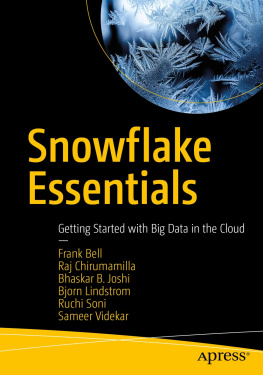Kishen Das Kondabagilu Rajanna - Getting Started with CockroachDB: A guide to implementing a modern cloud-native and distributed SQL database for your data-intensive apps
Here you can read online Kishen Das Kondabagilu Rajanna - Getting Started with CockroachDB: A guide to implementing a modern cloud-native and distributed SQL database for your data-intensive apps full text of the book (entire story) in english for free. Download pdf and epub, get meaning, cover and reviews about this ebook. year: 2022, publisher: Packt Publishing - ebooks Account, genre: Home and family. Description of the work, (preface) as well as reviews are available. Best literature library LitArk.com created for fans of good reading and offers a wide selection of genres:
Romance novel
Science fiction
Adventure
Detective
Science
History
Home and family
Prose
Art
Politics
Computer
Non-fiction
Religion
Business
Children
Humor
Choose a favorite category and find really read worthwhile books. Enjoy immersion in the world of imagination, feel the emotions of the characters or learn something new for yourself, make an fascinating discovery.
- Book:Getting Started with CockroachDB: A guide to implementing a modern cloud-native and distributed SQL database for your data-intensive apps
- Author:
- Publisher:Packt Publishing - ebooks Account
- Genre:
- Year:2022
- Rating:3 / 5
- Favourites:Add to favourites
- Your mark:
Getting Started with CockroachDB: A guide to implementing a modern cloud-native and distributed SQL database for your data-intensive apps: summary, description and annotation
We offer to read an annotation, description, summary or preface (depends on what the author of the book "Getting Started with CockroachDB: A guide to implementing a modern cloud-native and distributed SQL database for your data-intensive apps" wrote himself). If you haven't found the necessary information about the book — write in the comments, we will try to find it.
Get hands-on with deploying and managing your database services to provide scalable and high-speed data access on CockroachDB
Key Features- Gain insights into CockroachDB and build highly reliable cloud-native applications
- Explore the power of a scalable and highly available cloud-native SQL database to automatically distribute data and workload demand
- Build high-speed database services using CockroachDB and troubleshoot performance issues
CockroachDB is a trending distributed SQL database for building scalable cloud services. This book will introduce you to CockroachDB and help you understand how it provides high-speed data access by storing copies of data in multiple physical locations. With this book, youll see how you can use the database to provide solutions where the data is highly available.
Starting with CockroachDBs installation, setup, and configuration, this book will familiarize you with the database architecture and database design principles. Youll then discover how CockroachDB stores copies of your data to ensure fast data access. The book covers the internals of CockroachDB, how to deploy and manage it on the cloud, performance tuning to get the best out of CockroachDB, and how to scale data across continents and serve it locally. In addition to this, youll get to grips with fault tolerance and auto-rebalancing, how indexes work, CockroachDB Admin UI, and much more. The book will guide you in building scalable cloud services on top of CockroachDB, covering administrative and security aspects and tips for troubleshooting, deployment, and other performance enhancement aspects.
By the end of this book, youll have the knowledge you need to manage your data on CockroachDB and interact with it from your application layer.
What you will learn- Become well-versed with the overall architecture and design concepts of CockroachDB
- Understand how constant resharding of data can avoid performance bottlenecks
- Get to know how CockroachDB achieves atomicity, consistency, isolation, and durability
- Partition your data across multiple geolocations to ensure very low latency when serving data
- Find out how indexes are stored and the optimizations used to serve query results faster
- Get to grips with key concepts of deploying and managing CockroachDB clusters
Database developers, database administrators, and anyone who wishes to learn about the features of CockroachDB and how to build database solutions that are fast as well as highly available business-critical applications will find this book useful. Although no prior exposure to CockroachDB is required, familiarity with database management will help you to get the most out of this book.
Table of Contents- CockroachDB - A Brief Introduction
- How Does CockroachDB Work Internally?
- Atomicity, Consistency, Isolation, and Durability (ACID)
- Geo-Partitioning
- Fault Tolerance and Auto-Rebalancing
- How Indexes Work in CockroachDB
- Schema Management
- Using Admin UI
- Security Aspects
- Troubleshooting Issues
Kishen Das Kondabagilu Rajanna: author's other books
Who wrote Getting Started with CockroachDB: A guide to implementing a modern cloud-native and distributed SQL database for your data-intensive apps? Find out the surname, the name of the author of the book and a list of all author's works by series.














